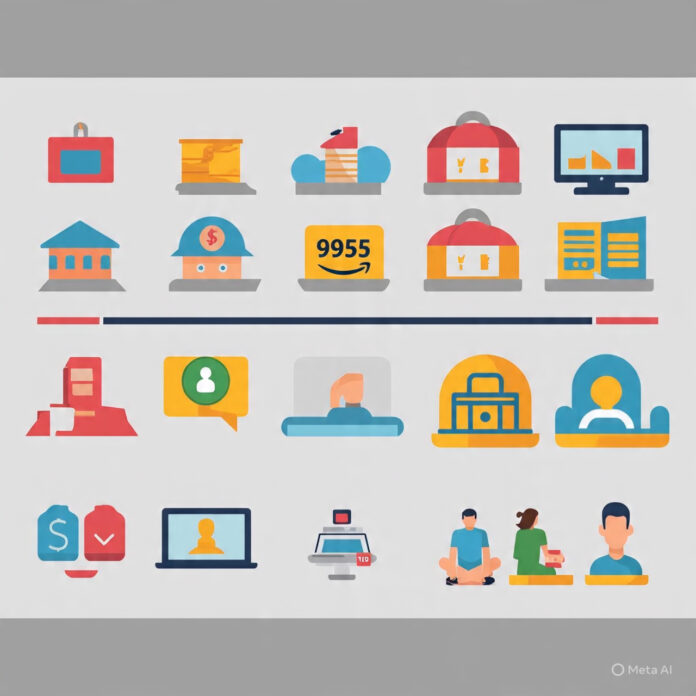📅 Historical Context: Retail Before The Internet (Pre-1995)
Before the dawn of the internet, retail was synonymous with physical stores. Department giants like Sears, Kmart, and Walmart anchored malls and shopping centers across America. The retail experience was tactile: customers browsed shelves, chatted with sales associates, and brought home purchases after standing in line. Loyalty was built through personal service, catalogs, and location convenience.
Transactions relied on cash registers and traditional advertising—print, TV, and radio ruled marketing budgets. The possibilities of remote or home shopping were limited to telephone ordering and catalog mail-ins, such as those offered by Sears’ iconic catalog, but these were niche compared to the vast, in-person consumer economy.
🚀 The E-Commerce Wave: Amazon & Digital Disruption
Everything changed in July 1995 with the launch of Amazon.com. Initially a humble online bookstore, Amazon’s model set a precedent for digital-retail potential—offering convenience, choice, and lower prices. It sidestepped physical boundaries, letting shoppers order “A to Z” from their homes.
Other trailblazers quickly followed:
- eBay (1995): Introduced online auctions and C2C exchanges, democratizing commerce beyond formal retailers.
- Alibaba (1999): Revolutionized business and consumer markets in Asia, showing global e-commerce’s power.
Amazon continued to innovate: the customer review system built trust; the launch of Prime in 2005 redefined shipping expectations; and the Kindle in 2007 did for books what MP3s did for music. Meanwhile, PayPal (spawned by eBay) simplified secure transactions, solving another digital shopping hurdle.
Case Study Example: In 2000, Amazon’s annual revenue crossed $2.76 billion. Fast-forward to 2023, and the figure swelled to over $500 billion, with Amazon accounting for roughly 40% of U.S. e-commerce sales1.
🏬 Brick-and-Mortar Adaptation: Reinvention, Not Extinction
Physical stores didn’t disappear—instead, they evolved:
- Loyalty Programs: Chains like Target and CVS introduced digital rewards and apps to encourage repeat visits and data-driven marketing.
- In-Store Technology: Touchscreen kiosks, mobile checkout, and beacon-triggered promotions modernized shopping, merging physical and digital.
- Omnichannel Integration: Leading retailers, from Walmart to Best Buy, launched BOPIS (buy online, pick up in store), curbside pickup, and real-time inventory apps to marry online ease with local convenience.
- Experiential Retail: Brands (see Apple Stores, Nike’s flagship outlets) turned stores into immersive experiences—tech demos, mini-events, and expert consultations, driving shoppers off their couches and into branded environments.
Case Study Example: Walmart’s strategy of heavily investing in both online infrastructure and improving in-store experiences helped it overtake Amazon in total U.S. retail revenue, even as e-commerce soared.
📊 E-Commerce vs. Brick-and-Mortar: Market Trends and Consumer Preferences
Growth Statistics:
- In 1999, U.S. e-commerce sales were under 1% of retail sales.
- By 2019, this rose to ~11% (U.S. Census Bureau).
- By Q3 2023, e-commerce soared to over 15% of total retail—driven by pandemic shifts.
- Globally, e-commerce generated almost $6 trillion in 2023 (Statista), up from less than $200 billion in 1999.
Consumer Trends:
- 73% of U.S. consumers shop online at least monthly (Pew Research, 2023).
- But 46% still prefer to see/touch items before buying (ICSC 2023 retail survey).
Revenue Shifts (2010-2023):
| Year | U.S. E-Commerce Revenues (USD Billions) | Brick-and-Mortar Revenues (USD Trillions) |
|---|---|---|
| 2010 | $165 | $3.6 |
| 2019 | $602 | $4.9 |
| 2023 | $1,118 | $5.2 |
Source: U.S. Census Bureau, Statista
🔄 Pandemic Acceleration: COVID-19’s Digital Catalysis
The COVID-19 pandemic forced millions online as lockdowns shuttered stores. Retailers faced “digital Darwinism”—adapt or risk extinction. Online grocery shopping exploded (Instacart, Amazon Fresh), curbside pickups went mainstream, and previously hesitant demographics (like seniors) embraced e-commerce.
Case Study Example: Target’s digital sales doubled in 2020, with 95% of these orders fulfilled by stores, illustrating the synergy of physical + digital (“phygital”) commerce.
🔮 The Future of Retail: Toward a Hybrid and Personalized Era
- Hybrid Models Dominate: The future isn’t online vs. offline but seamless integration. Think Amazon’s “Just Walk Out” stores or Best Buy’s consultative services paired with online convenience.
- Experiential Retail: Stores as destinations—flagships offering events, workshops, and personalized fitting.
- Automation & Delivery Tech: Drones (Amazon Prime Air), delivery robots, and even autonomous vehicles are reshaping last-mile logistics.
- AI-Driven Personalization: Machine learning tailors product recommendations, pricing, and customer service (e.g., chatbots, virtual stylists).
- Sustainability and Localism: Consumers increasingly value eco-friendly packaging and support for local businesses, spurring innovative “local” online models.
Conclusion: A Converging Landscape
From Amazon’s beginnings as an online bookstore to today’s hybrid, AI-enhanced shopping landscape, retail has evolved beyond recognition. While e-commerce continues its meteoric rise, the ingenuity of brick-and-mortar ensures both models will not only coexist but increasingly interweave. Tomorrow’s winners will be brands and retailers mastering this convergence—where experience, convenience, and technology unite to serve the ever-changing customer.
